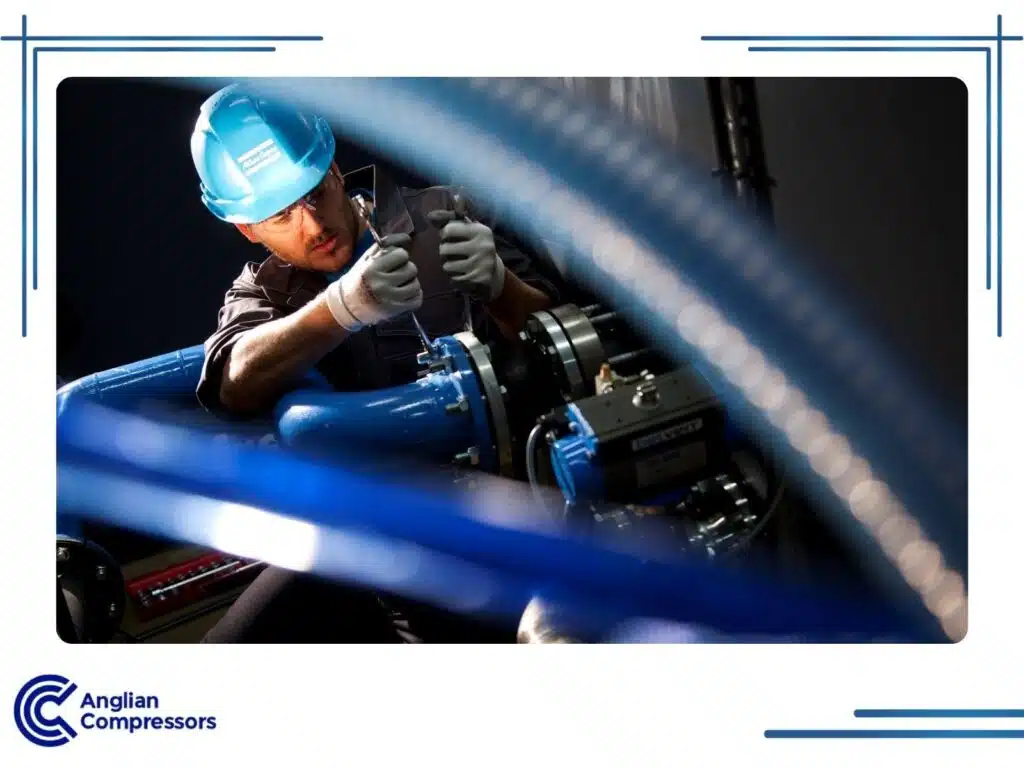What Is an Air Receiver?
An air receiver is an essential element of any compressed air system. Also known as compressed air tanks or reservoirs, air receivers serve as temporary storage tanks that enable your system to effectively manage fluctuations in air demand. Depending on its configuration, an air receiver can offer numerous benefits, including enhanced energy efficiency, improved productivity, and significant cost savings.
This guide provides everything you need to know about air receivers to help you select the most suitable solution for your compressed air system. At Anglian Compressors, we have been installing, repairing, and maintaining air compressors and receivers since 1977, and our team is ready to assist with any questions you might have.
How Air Receivers Work
An air receiver acts as a buffer between the air compressor and the system, ensuring steady airflow, pressure stability, and improved efficiency. While a system can operate without one, doing so increases wear, energy costs, and pressure fluctuations.
1. Air Storage and Pressure Regulation
The air receiver stores compressed air, releasing it when demand spikes. This ensures consistent pressure across the system.
- Prevents pressure drops, keeping pneumatic tools running smoothly.
- Reduces strain on the compressor, minimising wear and tear.
2. Optimising Compressor Efficiency
Without an air receiver, compressors cycle on and off frequently, leading to higher energy costs and reduced lifespan.
- Reduces cycling, improving efficiency and longevity.
- Supports load/unload operation, keeping airflow stable.
3. Moisture Separation and Air Quality
Compressed air contains moisture, which can cause corrosion and equipment damage. Air receivers help remove excess moisture before it reaches tools.
- Enhances air quality, protecting equipment and filters.
- Minimises maintenance costs, extending system life.
4. Managing Fluctuating Air Demand
An air receiver absorbs sudden changes in air usage, preventing compressors from overworking.
- Handles peak demand periods without pressure drops.
- Ensures consistent airflow for multiple workstations.
Why It Matters
An air receiver stabilises air pressure, improves efficiency, and reduces energy costs. As an Atlas Copco UK distributor, Anglian Compressors can help you find the right solution. Contact us today for expert advice.
Real-World Applications for Air Receivers
Real-World Applications for Air Receivers
Air receivers are used across a wide range of industries. Here are some typical applications:
- Manufacturing Plants: ensure a constant air supply for operating pneumatic tools and machinery, improving workplace efficiency while minimising compressor wear.
- Construction Sites: store air for powering tools like jackhammers, paint sprayers, and nail guns, allowing seamless tool changes without straining the compressor.
- Automotive Workshops: provide reliable air for cleaning, tyre inflation, and operating tools such as impact wrenches, especially during peak demand.
- Chemical Processing: support applications such as mixing chemicals and controlling reactions.
- Hospitals: supply air for operating medical devices, including breathing apparatus and surgical tools, ensuring reliability in critical environments.
- Food and Beverage Manufacturing: enable tasks such as pneumatic conveying, cleaning, and packaging while adhering to food safety standards.

Different Types of Air Receiver
Choosing the right air receiver depends on air demand, space, and system configuration. Here is a breakdown of the key types:
Tank-Mounted Air Receivers vs Stand-Alone Air Receivers
- Tank Mounted – integrated with the compressor, ideal for small systems (up to 26kW/35HP). Easy to install and cost effective for workshops and mobile setups.
- Stand Alone – a separate tank that stores extra compressed air to handle demands the compressor alone cannot meet. Ideal for industrial and high-consumption applications.
Vertical vs Horizontal Configurations
- Vertical Receivers – space saving, better condensate drainage, and ideal for compact factory layouts.
- Horizontal Receivers – more stable and easier to maintain, often used in transportable and mobile systems.
High-Pressure Air Receivers vs Low-Pressure Air Receivers
- Low Pressure (up to 150 PSIG / 10 BAR) – used in general manufacturing, workshops, and pneumatic tools.
- High Pressure (above 150 PSIG / 10 BAR) – required for laser cutting, PET bottling, and aerospace applications.
Benefits of Using an Air Receiver
While an air receiver is not mandatory, it significantly improves system efficiency, reliability, and cost savings, especially when handling demands that the compressor alone cannot meet.
1. Stable Air Pressure and System Performance
- Prevents pressure drops, ensuring a consistent air supply, crucial for spray painting, CNC machining, and industrial automation.
- Reduces compressor cycling, preventing wear and tear in high-demand operations.
2. Optimised Compressor Operation and Lower Costs
- Extends compressor lifespan by reducing load/unload cycles.
- Cuts energy costs by reducing power surges and optimising efficiency.
3. Emergency Backup and Reduced Downtime
- Provides stored compressed air when the compressor cannot meet sudden peak demands.
- Essential for critical industries like healthcare, food processing, and high-precision manufacturing.
4. Improved Condensate Management and Air Quality
- Traps moisture to prevent corrosion, contamination, and damage.
- Extends filter life, reducing maintenance costs.
5. Flexibility for Fluctuating Air Demand
- Absorbs demand spikes, ensuring tools and machinery receive steady airflow.
- Supports multi-tool and multi-station operations in garages, workshops, and industrial sites.
Air Receiver Maintenance and Safety Tips
Here’s some crucial advice to help you keep your air receiver and compressed air systems in top shape for as long as possible:
Draining the air receiver tank
If your air compressor doesn’t have a built-in dryer or lacks a draining system, moisture can build up in your air tank. This untreated, wet, compressed air can damage your equipment and compromise the quality of your products. At Anglian Compressors, we recommend draining your air receiver daily, though you might have to drain it numerous times per day depending on how frequently you use it. You might want to invest in a time drain, float drain or electronic drain valve, to make the task easier.
Condensate must be drained regularly to prevent moisture damage. Daily drainage is recommended, though the frequency depends on system usage. Consider installing automatic drains, such as time-controlled or electronic valves to simplify this.
Choosing the correct pressure
The receiver’s pressure rating must exceed the compressor’s maximum output. For instance:
- A fixed-speed compressor delivering 125 psig (8 bar) requires a receiver rated at 150 psig (10 bar).
- A VSD compressor, typically rated up to 175 psig (12 bar), needs a receiver rated at 200 psig (14 bar).
Need Help Selecting an Air Receiver? Contact Our Experts
At Anglian Compressors, we’ve been one of the UK’s leading suppliers and installers of air compressors and receivers for decades, and we’ve been a premier distributor for Atlas Copco since 1977. If you need help choosing the most suitable air receiver for your compressed air systems, don’t hesitate to give us a call for advice and a no-obligation quote.
If you’d like, we’ll be more than happy to send a knowledgeable compressed air professional to your site so that we can recommend a solution based on your unique requirements. Contact us today, and we’ll gladly provide more information.
Frequently Asked Questions About Air Receivers
What is the difference between a wet and dry air receiver?
A wet air receiver is placed before the air dryer and helps to cool compressed air, allowing moisture to condense and be removed. On the other hand, a dry air receiver is installed after the dryer and stores air that has already been treated, ensuring a stable supply of clean, dry, compressed air to the system.
How do I determine the right size of air receiver for my system?
The size of an air receiver depends on factors such as compressor output, peak air demand, and system pressure requirements. A common guideline is to allocate approximately three to four gallons of receiver capacity per cubic foot per minute (CFM) of compressor output, ensuring efficient pressure stabilisation and energy savings.
Why is it important to drain condensate from an air receiver?
Due to compressed air cooling, moisture naturally accumulates in air receivers. Regular draining prevents corrosion, protects downstream equipment, and maintains air quality. Many systems use automatic drain valves to remove condensate efficiently without manual intervention.


